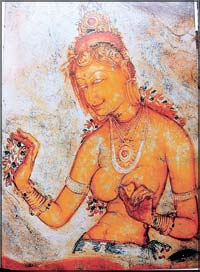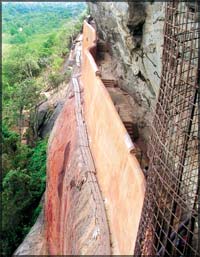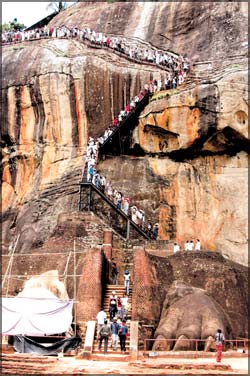Sigiriya
Shrouded in mystery and mystic aura:
Nilma Dole
Sigiriya took top honours by being the most significant wonder in Sri
Lanka which has already been declared as a UNESCO World Heritage site.
Not only does this stupendous rock fortress, ‘Lion’s Rock’ or ‘Mount
Remembrance’ the great palace of King Kassapa (AD 477 - 495) but the
intricate irrigation works, water gardens and reservoirs make it a
breathtaking monument.
Sigiriya has been a pivotal natural wonder where spirituality is
sandwiched by ambitious royalty where the ‘Mahavamsa’ states
different aspects of the story of King Kassapa.
|
Sigiriya has been a pivotal natural wonder where spirituality is
sandwiched by ambitious royalty where the ‘Mahavamsa’ states different
aspects of the story of King Kassapa.
In one, he is the son of King Dhatusena who murdered his father by
plastering him within the walls of Sigiriya and seizing the throne which
rightfully belonged to his brother Mogallana, Dhatusena’s son by the
true queen. With a vow to get revenge, Mogallana escaped to India and
raised an army to overthrow King Kassapa who knew of his brother’s
intentions and decided to build Sigiriya on a magma plug in a bid to
save himself.
|

A Sigiriya fresco |
|

Sigiriya’s graffiti wall |
Mogallana finally arrived and declared war but during the battle,
Kassapa’s armies abandoned him and he committed suicide by falling on
his sword.
Other stories say that the battle-elephant on which Kassapa was
mounted changed course just to get to a better fighting position/place
but the army misinterpreted it as the King fleeing. Thereafter the army
abandoned the king altogether.
Moggallana returned the capital to Anuradapura and turned Sigiriya
into a monastery complex. Alternative stories have that King Dhatusena
was Sigiriya’s cheif architect and Kassapa took over after to finish the
work in honour of his father.
Some popular stories revolve around Kassapa as a playboy king, with
Sigiriya as his pleasure palace and even so, Kassapa’s fate falls unto
him despicably. In some versions he is assassinated by poison
administered by a concubine whereas in others he cuts his own throat
when isolated in his final battle.
According to other sources, there have been indications that some of
the frescoes have been destroyed due to the fact that it was a religious
refuge by Buddhist monks as it wasn’t correct to have a ‘roving eye’
while praying.
Today, Sigiriya is getting help from the people of Japan who have
given the Ministry of Cultural Affairs a grant for building a landmark
museum provided by the JICA (Japanese International Cooperation
Development) agency at a sum of Rs.480 million.
Director General of the Central Cultural Fund and Professor of
Archaeology, University of Peradeniya and historian, Prof. Sudarshan
Seneviratne, said that the Sigiriya should be promoted as a Tourist
Village where visitors can not only discover the legend of Sigiriya for
themselves and climb up to the summit but also enlighten themselves on
the various cultural and traditional aspects of the world-renowned
fortress. Prof.
Seneviratne who is also the advisor to the UNESCO on declaring world
heritage sites said that Sigiriya needs to boost its economy by not just
delving into tourist aspects but also thinking of long-term viable
solutions to protect and preserve Sigiriya as climate change continues
to escalate in the world.
With effect, it would be beneficial, he said if a helping hand is
given to the community if tourists stay for more than 5 hours. “It is
good that today’s economically sound tourist wants to go to a
destination which offers everything from the beaches to Ayurveda
treatments and most importantly, heritage sites which is prevalent in
our Cultural Triangle making Sri Lanka a bio diverse and
culturally-renowned hotspot destination. “It is high time we uplift our
cultural and historical heritage to make it better for our tourism
sector to develop,” he commented.
Cultural Affairs Minister Mahinda Yapa Abeywardena said that by way
of protection and preservation of Sigiriya, it will soon be a reality to
make it an eighth wonder.
“We aim to develop a cultural-oriented tourism all around the country
and already around the world, the response for visiting Sri Lanka is
immense despite the current situation,” he said. “Our present and future
generations should realise how important it is to preserve and uplift
Sigiriya which is a national treasure,” the Minister concluded.
Oldest landscaped gardens
|

Visitors climbing up Sigiriya |
The Gardens of the Sigiriya - Vital aspects of the site is among the
oldest landscaped gardens in the world according to Prof. Seneviratne.
The gardens are divided into three distinct but linked forms; water
gardens, Cave and boulder gardens, and terraced gardens.
a) The Water Gardens: Seen in the central section of the western
precinct the location for three main gardens.
The first garden comprises an island surrounded by water that is
connected to the main precinct using four causeways, with gateways
placed at the head of each causeway. This garden is built according to
an ancient garden form known as char bhag, and is one of the oldest
surviving models of this form.
The second contains two long, deep pools set on either side of the
path. Two shallow, serpentine streams lead to these pools. Fountains
made of circular limestone plates are placed here.
Underground water conduits supply water to these fountains which are
still functional, especially during the rainy season.
Two large islands are located on either side of the second water
garden. Summer palaces are built on the flattened surfaces of these
islands. Two more islands are located further to the north and the
south. These islands are built in a similar manner to the island in the
first water garden.
The third garden is situated on a higher level than the other two. It
contains a large, octagonal pool with a raised podium on its northeast
corner.
The large brick and stone wall of the citadel is on the eastern edge
of this garden. Special attributes: The water gardens are built
symmetrically on an east-west axis. They are connected with the outer
moat on the west and the large artificial lake to the south of the
Sigiriya rock.
All the pools are also interlinked using an underground conduit
network fed by the lake, and connected to the moats.
A miniature water garden is located to the west of the first water
garden, consisting several small pools and water courses. This recently
discovered smaller garden appears to have been built after the Kassapan
period, possibly between the tenth and thirteenth centuries.
b) The cave/boulder gardens: Comprising of several large boulders
linked with winding pathways. The boulder gardens extend from the
northern slopes to the southern slopes of the hills at the foot of
Sigiriya rock. Most of these boulders had a building or pavilion upon
them. There are cuttings on these boulders that were used as footings
for brick walls and beams.
The audience hall of the king was situated in the boulder garden, the
remains of which are seen on the flattened and polished summit of a
large boulder. There is also a five metre long granite throne in this
hall.
The throne is carved from the boulder itself, and is not separated
from it. Another notable feature in the boulder garden is the Cistern
rock, named after a large, carved cistern on top of the rock. A large
archway, created by two boulders, provides access to the terraced
gardens.
c) The Terraced Gardens: The terraced gardens are formed from the
natural hill at the base of the Sigiriya rock.
A series of terraces, each rising above the other, connect the
pathways of the boulder garden to the staircases on the rock. These have
been created by the construction of brick walls, and are located in a
roughly concentric plan around the rock. The path through the terraced
gardens is formed by a limestone staircase. From this staircase, there
is a covered path on the side of the rock, leading to the uppermost
terrace where the lion staircase is situated.
d) The Mirror Wall and Spiral Stairs leading to the Frescoes:
Originally this wall was so well polished that the king could see
himself whilst he walked alongside it.
Made of a kind of porcelain, the wall is now partially covered with
verses scribbled by visitors to the rock. Well preserved, the mirror
wall has verses dating from the 8th century.
People of all types wrote on the wall, on varying subjects such as
love, irony, and experiences of all sorts.
e) The Frescoes: The paintings would have covered most of the western
face of the rock, covering an area 140 metres long and 40 metres high.
There are references in the graffiti to 500 ladies in these paintings.
Some more frescos different from the popular collection can be seen
elsewhere on the rock surface, for example on the surface of the
location called the “Cobra Hood Cave”.
f) Sigiriya Site Plan: Sigiriya is considered one of the most
important urban planning sites of the first millennium, and the site
plan is considered very elaborate and imaginative.
The plan combined concepts of symmetry and asymmetry to intentionally
interlock the man-made geometrical and natural forms of the
surroundings. On the west side of the rock lies a park for the royals,
laid out on a symmetrical plan; the park contains water retaining
structures, including sophisticated surface/subsurface hydraulic
systems, some of which are working even today.
The south contains a man made reservoir, these were extensively used
from previous capital of the dry zone of Sri Lanka. Five gates were
placed at entrances. The more elaborate western gate is thought to be
reserved for the royals.
Disputes & truths
Sigiriya has so many disputes to offer. The foremost dispute is the
purpose on which it is built. Scholars entertain diverse opinions on the
purpose it is built. Some opine that King Kassapa built it as a military
fortress to protect from his brother Mugalan. Some maintain it was a
meditation monastery.
However as Dr Senarat Paranavithana categorically points out,
artistic remains give the lie to the belief that the Sigiri was a
military fortress. He explains that it was nothing but a resplendent
fortress built for King Kassapa's comforts.
|

A view of Sigiriya |
"The palace on the summit of the rock, the gallery and the ornamental
features on the hill-side, were of no use for purposes of defense, and
it was not to protect himself from enemeies, as some modern writers
aver, that Kasyapa built this unique residence and took up his abode
there. As the Chulavansa categorically states, Sigiri was built as a
replica of Alakamanda paradise on top of Mount Kailasa; and Kasyapa
resided there as the embodiment of Kuvera on earth." (Dr Paranavithana's
Sinhalayo)
He has been posthumously criticised for this view on Sigiri.
Professors A Liyanagamage and Siri Gunasinghe provide a scholarly
backing to Paranavithana's concept. They maintain that evidence in
Mahawamsa is not strong enough to convince the theory of Sigiri as a
military fortress. As Gunasinghe mentions, Mugalan had been away in
India for 18 years and posed no threat to him.
Nishantha Gunawardena a historian living in America exposes a Chinese
record from 527 CE of a letter sent by Kassapa to the Chinese court
which indicates that he kept good diplomatic contacts with the outer
world rather than being stuck down in a fortress. He also accepts the
fact that the chronicles contain loopholes. He observes that the chapter
40 in the sequence of Kassapa's legend is missing in Chulavamsa
mysteriously. Some scholars believe that this chapter never existed.
Dr Paranavithana comes across another story in inscriptions about the
two sons of Dhatusena, which maintains that Kassapa did not actually
kill his father. The story explains how Kassapa fulfilled his father's
wishes by building a strong rock fortress. Prof Gunasinghe also supports
the idea that Mahavamsa was wrong in labelling Kassapa as a patricide.
Scholars also entertain the theory that the frescoes have Ajantha
influence. Prof Gunasinghe sees no convincing evidence to prove this
theory, though he observes similarities between Ajantha and Sigiri
frescoes.
This theory sprang because Ajantha frescoes were discovered and were
already discussed when Sigiri frescoes came to the scene. Scholars have
different opinions about visitors and the scribes. Prof Paranavithana
suggests most of them were just ordinary visitors whose writings portray
the period they lived in.
This period shows a high literacy rate in the then society.
Gunasinghe's logic is that Kassapa should be understood to see Sigiri in
proper insights. Kassapa is introduced as a patricide in Mahawamsa.
However Gunasinghe's theory is that the Mahawamsa authors did it on
purpose for two reasons: Kassapa's mother is low-born and for that
matter the Mahavihara clergy did not have a good attitude about him.
On the chronicle narration of Dhatusena's torturing his own sister,
Gunasinghe raises the question as to how a great ruler as disclosed in
chronicles itself would have ever done any such thing. And the reasons
the chronicles lay down are not material evidence for it says that
Dhatusena did so because her son had whipped his wife, Dhatusena's
daughter.
The frescoes have sparked disputes too. Some take them as celestial
maidens, while some take them as Kassapa's concubines. Dr Paranavithana
believes it is a result of court ladies and other terrestrial beauties
of the time handing down the job of painting them to painters. Dr.
Gunasinghe disputes this theory saying that the frescoes are mere human
imaginations like Kalidasa's Megha Duta.
- Sachitra
Guardians of the rock fortress
Rock Bee attacks on visitors of Sigiriya had become a common news.
Thousands of deadly winged warriors, resembling military troops set
visitors in full flight after swarms descended upon them.
These bees are believed to be the reincarnation of the soldiers of
King Kassapa, the creator of the legendary rock fortress. It is their
duty to protect their residence despite sacrificing their lives for the
cause for the bee sting though extremely painful for victims results in
the death of the bee.
Loud noises, hot weather and sudden movements rouse the normally
peaceful bees. Local newspapers as well as signs in the Sigiriya
compound warn visitors against ‘bees, wasps or hornets’ of the ancient
fortress.

However expert on bees in Sri Lanka Dr. R.W.K. Punchihewa had stated
that the dwellers of the rock fortress are a species of bees better
known as Giant Honey bees or Rock Bees, scientifically termed Apis
dorsata.
In Sinhala they are called bambara and choose exposed areas like
below cliff overhangs, tree limbs or even buildings to build hives.
Each colony is made up of a single vertical comb covered with a mass
of bees. Unlike the oriental bees, Rock bees do not use enclosed
cavities, a reason which is attributed to their offensive behaviour.
Stinging bee attacks have been an ongoing issue in Sigiriya for many
years.
Many bee attacks have taken place within the walls of the World
Heritage Site in the past, the most recent one being at the end of March
this year, forcing the authorities to close the site temporarily. Is
there no permanent solution for this problem? Destroying the hives is
out of the question as many sees this as a removal of a part of the
heritage site itself. Bees are also an important link in the area’s
ecological chain.
Their disposal can have harmful effects on the pollination cycle of
plants. There is also the chance that the bees will return and build up
their hive on the original place.
Dr. Punchihewa had pointed out that the most appropriate solution
lies in the ability to control the bees’ flying route through ecological
means.
As bees depend on collecting nectar, the route to their prize must be
the same as that taken by visitors’ passages.
If their paths’ cross and a bees is killed in an attempt to drive him
away, a strange odour reaches the soldier bees preparing them for
attack.
Steps like building a barrier of vegetation to deviate the paths of
the bees as well as planting trees to lure bees into building nests on
them should have been taken some years back as Dr. Punchihewa had
briefed the authorities on the topic. He expressed that it is not too
late to take up the work of building trenches, selecting plants and
cultivating them as it enhances the beauty of the site as well as proves
to be the best solution for the problem.
- Ruwini
|



